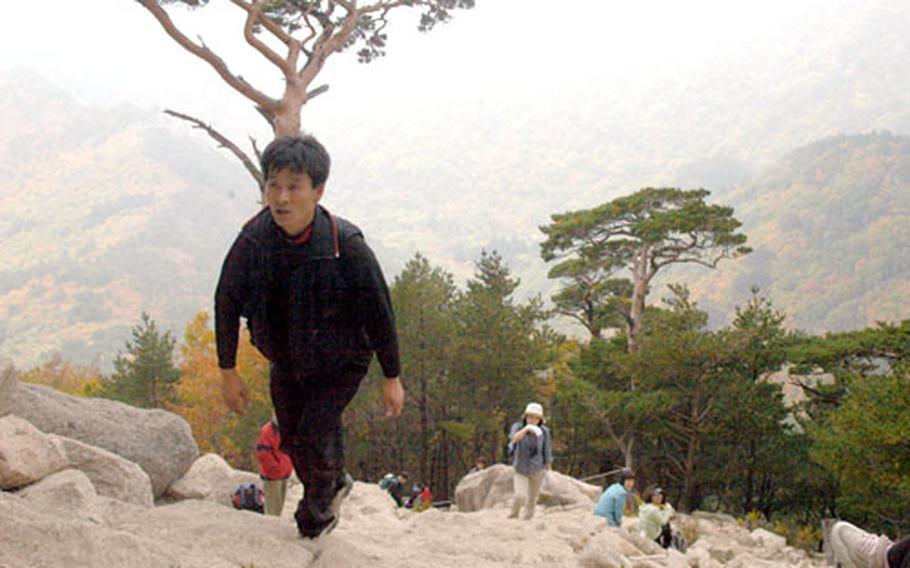
Hikers climb thousands of steps to the top of Ulsanbawi, one of the shorter climbs at Soraksan National Park in South Korea. (Seth Robson / S&S)
Towering peaks, multicolored foliage and crowds of middle-aged South Korean women are features of Soraksan National Park in autumn.
And in the next few weeks, the park will be at its most popular.
Near the port city of Sokcho in Kangwon province, Soraksan is Area I’s leading tourist attraction. It is about four hours from Uijongbu by bus, but if you’re driving, allow for six due to South Korea’s confusing road network and heavy traffic.
Soraksan, which means “snow summit mountains,” is always well visited, but peak tourist season is fall, when the leaves change color.
By 6 a.m., the parking area near the front entrance is packed with thousands of South Korean tourists preparing for a day’s hiking. Many are “ajumas,” the aforementioned Korean women traveling in groups and decked out in the latest high-tech outdoor wear.
Entrance costs 3,200 won (about $3). Inside, an expanse of valley floor has been cleared beside a rocky riverbed and filled with restaurants, temples and statues, including a house-sized Buddha. One of the temples, the Shinhung-sa Monastery, built in 652 AD, is the oldest continually used Zen meditation temple in Korea.
Hawkers peddle everything from cameras to walking sticks and toys. A particularly useful item for sale is a bandana stamped with a trail map of the park. The map shows numerous tracks ranging from easy strolls around the valley floor to arduous climbs to the summits of the surrounding peaks.
The highest peak is Daecheonbong (5,600 feet), a strenuous, 12-hour hike when there is no snow. Ulsanbawi, a shorter clamber up a sheer cliff face, resembles Yosemite National Park’s Half Dome. Along the way there are plenty of restaurants and food vendors that set themselves up at strategic forest locations.
Occasionally, porters struggling under the weight of overloaded backpacks can be seen lugging supplies for the shops up the winding trails.
Heundeulbawi (Tottering Rock) is halfway up the hill. It’s the size of a Humvee and rocks back and forth if you push it but never rolls off the even-larger rock it sits on.
Next door is Gyejoam, a small cave temple established in the seventh century by a “leaned monk.” The sign next to the temple probably should have read “learned” but, like most of the signs in the park, it was written in a Korean take on English.
From there, the climb gets steeper. At the bottom of Ulsanbawi’s cliff face, the South Koreans have erected a steel staircase with 649 steps leading to the summit. There are spectacular views of the surrounding peaks on the way up, but sometimes mists cover the top and all you’ll see are dozens of Koreans calling friends on their cell phones and buying shiny Olympic-style medals to mark their climb.
On the way down, visitors celebrate their achievement by singing and handing out sweets to would-be Ulsanbawi champions on their way up.
For people with limited energy, there is a cable car near the park entrance that will take you close to the summit of Mount Kwongumsong — a jagged escarpment that rises like a dagger above the park entrance.
From the cable car, which costs 7000 won (around $6) to ride, you can see Ulsanbawi, Sokcho and beaches stretching along the east coast.
However, for a much better view, climb a few hundred feet higher to Mount Kwongumsong’s summit. From near the summit you can see many of Soraksan’s most famous mountaintops and passes.
And for extra excitement, try clambering right to the summit itself, an exercise involving hand-over-hand climbing up a steep rock with the help of smaller rocks glued to the face as hand and footholds.
Yes, the park is crowded during peak season. No, you will not find the peace and tranquility you might find in national parks in some other countries. But when it comes to hiking and spectacular scenery, Soraksan ranks as one of South Korea’s wonders.